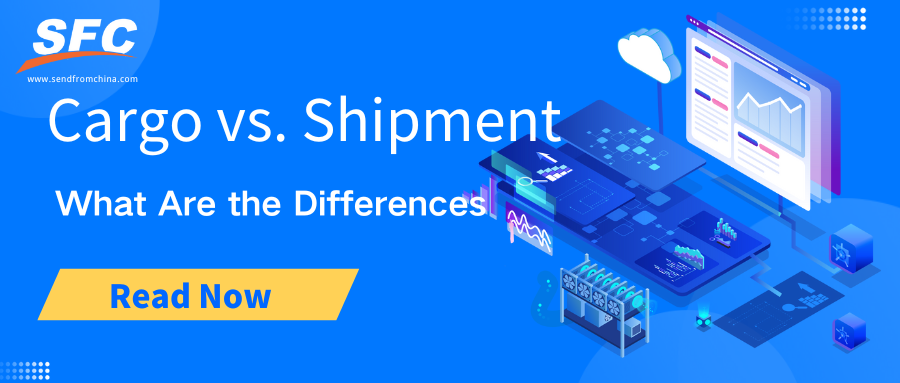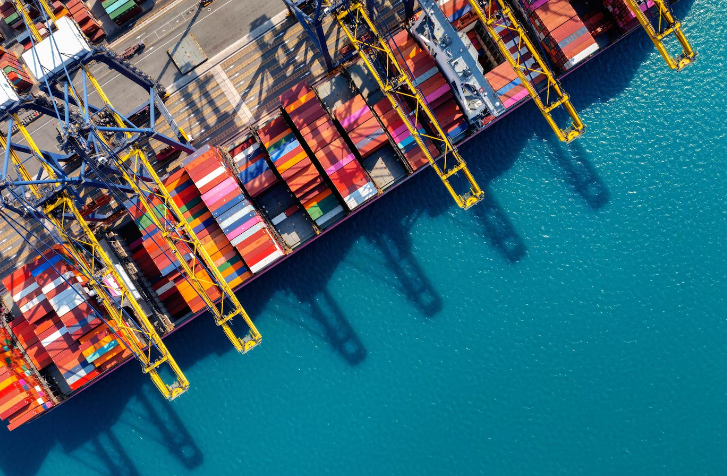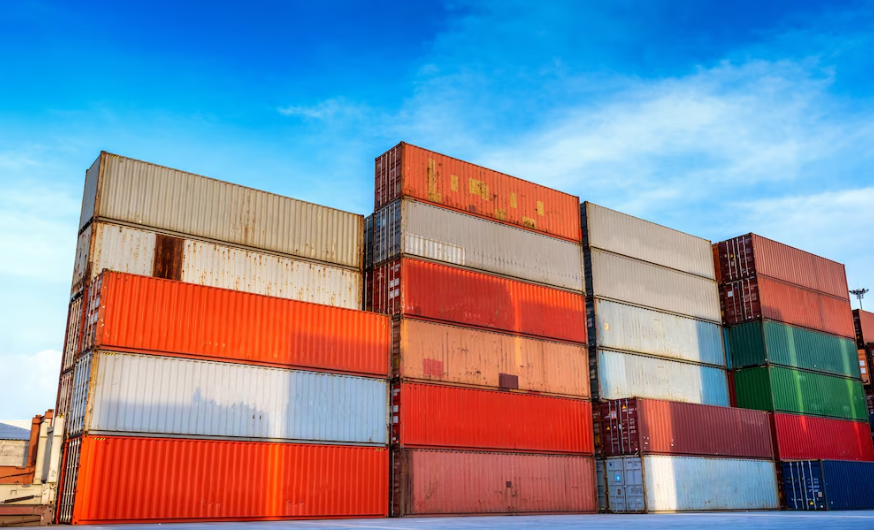Table of Contents
Get Custom eCommerce Fulfillment Service
Book a Meeting
Cargo vs. Shipment: What Are the Differences
Time: Jun 13,2025 Author: SFC Source: www.sendfromchina.com
Within logistics and supply chain operations, terminology must be precise to avoid miscommunication. While cargo and shipment both describe transported goods, they differ in scope: cargo typically refers to the goods themselves, whereas shipment encompasses the entire process of dispatch, transit, and delivery.Understanding the nuances between cargo and shipment is not merely an academic exercise; it has practical implications for businesses, logistics providers, and customers alike. Misinterpretations can lead to logistical errors, compliance issues, and financial losses. For instance, mislabeling cargo can result in customs delays, while misunderstanding shipment terms can affect insurance coverage and liability.

This comprehensive guide aims to demystify these terms by delving into their definitions, highlighting their differences, exploring the modes of transportation, and discussing the associated documentation and insurance considerations. By the end of this article, readers will have a clear understanding of how cargo and shipments function within the broader logistics framework, enabling more informed decisions and effective communication in the realm of goods transportation.
1. What Is Cargo
In the realm of logistics and transportation, cargo refers to the goods or commodities transported from one location to another via various modes such as ships, aircraft, trains, or trucks. These goods can range from raw materials and industrial equipment to consumer products and perishables. The term "cargo" is often used interchangeably with "freight," though nuances exist between the two depending on context.Definition and Scope
Cargo encompasses all items transported for commercial gain, excluding the means of transport themselves. This includes goods moved domestically or internationally, whether packaged or unpackaged, and regardless of the transportation mode. The primary objective is the delivery of these goods from the point of origin to the destination efficiently and safely.Types of Cargo
Understanding the various categories of cargo is essential for effective logistics planning. Here are the primary types:- General Cargo: These are goods packaged in boxes, crates, or pallets, such as electronics, clothing, and machinery. They are typically transported in containers to facilitate handling and protection.
- Bulk Cargo:
Dry Bulk: Unpackaged goods like grains, coal, and minerals transported in large quantities.
Liquid Bulk: Liquids such as crude oil, chemicals, and beverages transported in tankers.
- Break Bulk Cargo: Items that must be loaded individually, not in containers, such as heavy machinery or construction materials. This method is less common today due to the rise of containerization.
- Containerized Cargo: Goods transported in standardized containers, allowing for easy transfer between different transportation modes without handling the cargo itself.
- Project Cargo: Large, complex pieces of equipment or materials, often for specific projects like infrastructure development. These require specialized handling and transportation methods.
- Hazardous Cargo: Materials that pose risks to health, safety, or the environment, such as explosives, flammable liquids, or toxic substances. Transporting these requires strict adherence to safety regulations.
- Perishable Cargo: Goods that have a limited shelf life, like food products or pharmaceuticals, requiring temperature-controlled environments during transit.
Importance in Global Trade
Cargo transportation is the backbone of global trade, facilitating the movement of goods across borders and continents. Efficient cargo handling ensures timely delivery, cost-effectiveness, and the smooth operation of supply chains. With over 80% of global trade by volume carried by sea, understanding cargo dynamics is crucial for businesses engaged in international commerce.2. What Is Shipment
In the realm of logistics and transportation, the term shipment encompasses both the physical goods being transported and the comprehensive process involved in moving these goods from one location to another. Unlike "cargo," which specifically refers to the items themselves, "shipment" integrates the planning, execution, and management aspects of transporting goods, making it a pivotal concept in supply chain operations.
Dual Definition of Shipment
- The Process of Transportation: Shipment refers to the entire procedure of moving goods, which includes activities such as order processing, packaging, labeling, documentation, carrier selection, tracking, and last-mile delivery. This process ensures that products reach their intended destination efficiently and safely.- The Goods Being Transported: In another context, shipment can denote the actual goods or consignment being moved. For instance, a company might refer to "a shipment of electronics" arriving at their warehouse, emphasizing the physical items in transit.
Understanding this duality is crucial, as it highlights that shipment is not just about the goods but also about the intricate processes that facilitate their movement.
3. Key Differences Between Cargo and Shipment
A common misconception in logistics equates "cargo" with "shipment." In reality, cargo represents just the physical items being moved, whereas shipment includes all associated transportation activities - a crucial differentiation for supply chain professionals.Aspect |
Cargo | Shipment |
|---|---|---|
Definition |
Physical goods being transported | Process of transporting goods |
Focus |
The items themselves | The logistics and movement of the items |
Documentation |
Product-specific documents | Comprehensive transport documentation |
Tracking |
Inventory and item-level tracking | Journey and delivery tracking |
Industry Usage |
Bulk transport contexts | Retail and order fulfillment contexts |
4. Modes of Transportation: How Cargo and Shipments Travel
The movement of cargo and shipments relies on various transportation modes, each tailored to specific needs based on factors like distance, cost, speed, and the nature of the goods. Understanding these modes is crucial for optimizing supply chain efficiency and ensuring timely deliveries.
Road Transportation
Road transport is one of the most versatile and widely used modes, offering door-to-door service and flexibility in routing. It is particularly effective for short to medium distances and is integral to last-mile delivery.Advantages:
- High accessibility to remote areas.
- Suitable for both small parcels and large freight.
- Flexible scheduling and routing.
Considerations:
- Subject to traffic congestion and weather conditions.
- Higher carbon emissions compared to rail or sea transport.
Rail Transportation
Rail transport is ideal for moving large volumes of goods over long distances, especially inland. It offers a cost-effective and environmentally friendly alternative to road transport.Advantages:
- High capacity for bulk goods.
- Lower fuel consumption per ton-mile.
- Reliable schedules.
Considerations:
- Limited to areas with rail infrastructure.
- Requires additional modes for door-to-door shipping.
Maritime (Sea) Transportation
Maritime transport is the backbone of international trade, handling approximately 80% of global freight by volume. It is the most economical mode for transporting large quantities of goods over long distances.Advantages:
- Cost-effective for bulk and containerized cargo.
- Suitable for heavy and oversized goods.
- Lower environmental impact per ton-mile.
Considerations:
- Slower transit times.
- Dependent on port infrastructure and weather conditions.
Air Transportation
Air transport is the fastest mode, ideal for time-sensitive and high-value shipments. While more expensive, it ensures rapid delivery across long distances.Advantages:
- Quick transit times.
- High security and reduced risk of damage.
- Global reach.
Considerations:
- Higher costs.
- Limited capacity for heavy or bulky items.
- Subject to strict regulations and customs procedures.
Intermodal Transportation
Intermodal transportation combines two or more modes, such as rail and truck or sea and rail, to move goods efficiently. It leverages the strengths of each mode while mitigating their individual limitations.Advantages:
- Optimized cost and transit times.
- Reduced handling of cargo, minimizing damage.
- Flexibility in routing and scheduling.
Considerations:
- Requires coordination among different carriers.
- Potential for delays at transfer points.
Pipeline Transportation
Pipelines are specialized for transporting liquids and gases, such as oil, natural gas, and water, over long distances. They offer a continuous and efficient flow of materials.Advantages:
- Low operating costs.
- Minimal environmental impact during operation.
- Reliable and consistent delivery.
Considerations:
- High initial infrastructure investment.
- Limited to specific types of cargo.
- Environmental concerns in case of leaks or spills.
Selecting the Appropriate Mode
Choosing the right transportation mode depends on various factors:- Nature of the Cargo: Perishable goods may require faster modes like air transport, while bulk commodities are suited for rail or sea.
- Distance and Destination: International shipments often rely on maritime or air transport, whereas domestic deliveries may use road or rail.
- Cost Constraints: Budget considerations can influence the choice between faster, more expensive modes and slower, cost-effective ones.
- Time Sensitivity: Urgent deliveries necessitate quicker modes, despite higher costs.
5. What's in Shipment
A shipment encompasses more than just the physical goods being transported; it includes a comprehensive array of components and documentation that ensure the efficient, legal, and safe movement of products from origin to destination. Understanding these elements is crucial for businesses and individuals involved in logistics and international trade.
Physical Contents of a Shipment
At its core, a shipment contains the tangible items being moved. These can vary widely depending on the nature of the goods and the industry involved.- Consumer Goods: Items such as electronics, clothing, and household products.
- Industrial Equipment: Machinery, tools, and parts used in manufacturing or construction.
- Perishable Items: Food products, pharmaceuticals, and other goods requiring temperature control.
- Hazardous Materials: Chemicals and substances that require special handling and documentation.
Proper packaging and labeling of these items are essential to protect them during transit and to comply with regulatory requirements.
6. Documentation and Regulatory Compliance
Effective international logistics requires precise documentation and rigorous compliance - essential for smooth border crossings, avoiding delays, and meeting all legal and safety requirements.
Essential Shipping Documents
Accurate and comprehensive documentation is the backbone of any successful shipment. Key documents include:- Commercial Invoice: Details the transaction between the buyer and seller, including the value, description, and terms of sale.
- Bill of Lading (BOL): Serves as a contract between the shipper and carrier, a receipt for the goods, and a document of title.
- Packing List: Provides a detailed breakdown of the shipment's contents, aiding in inventory management and customs clearance.
- Certificate of Origin: Indicates the country where the goods were manufactured, which can affect tariffs and trade agreements.
- Import/Export Licenses: Required for certain goods, ensuring compliance with national regulations.
Each of these documents plays a critical role in facilitating international trade and ensuring that shipments meet all legal and regulatory requirements.
Regulatory Compliance in Shipping
Compliance with international and national regulations is essential to avoid legal penalties, ensure safety, and maintain the integrity of the supply chain. Key aspects include:- Customs Regulations: Adhering to the import and export laws of the countries involved, including proper classification of goods and payment of duties and taxes.
- Safety Standards: Ensuring that shipments, especially those containing hazardous materials, comply with safety regulations to prevent accidents and environmental harm.
- Environmental Regulations: Complying with laws aimed at minimizing the environmental impact of shipping activities, such as emissions standards and waste disposal protocols.
Staying informed about regulatory changes and implementing robust compliance programs are vital for businesses engaged in international shipping.
7. Insurance Considerations: Protecting Goods and Processes
Global shipping involves numerous risks—from damaged goods to lost containers. Cargo insurance acts as a financial safety net, with different policy types covering various scenarios. Smart shippers analyze their risk exposure to select optimal coverage that balances protection with cost.
The Importance of Shipping Insurance
Shipping goods, whether domestically or internationally, exposes them to a myriad of risks, including theft, damage, loss, and delays. While carriers may offer limited liability coverage, it often falls short of covering the full value of the goods. Comprehensive shipping insurance provides an added layer of protection, ensuring that businesses are compensated for losses beyond the carrier's liability.Types of Cargo Insurance
Several types of cargo insurance are available, each tailored to specific needs and risk profiles:- All-Risk Insurance: This is the most comprehensive coverage, protecting against all risks of physical loss or damage from external causes, except those specifically excluded. It's suitable for high-value or fragile goods.
- Named Perils Insurance: This policy covers only the risks explicitly listed, such as fire, theft, or collision. While more affordable, it offers narrower protection and requires a thorough understanding of the covered perils.
- Total Loss Only Insurance: This coverage applies only when the entire shipment is lost or destroyed. It's often chosen for low-value goods where partial damage is less concerning.
- Warehouse-to-Warehouse Coverage: This clause extends coverage from the point of origin to the final destination, including interim storage, ensuring continuous protection throughout the shipment's journey.
Factors Influencing Insurance Decisions
When selecting appropriate insurance coverage, businesses should consider several factors:- Value of Goods: High-value items necessitate comprehensive coverage to mitigate potential significant financial losses.
- Nature of Goods: Fragile, perishable, or hazardous materials may require specialized insurance policies that address their unique risks.
- Mode of Transportation: Different transportation methods (air, sea, land) present varying risks, influencing the choice of insurance.
- Shipping Routes: Routes through regions prone to political instability, piracy, or severe weather may necessitate additional coverage.
- Incoterms: International Commercial Terms (Incoterms) define the responsibilities of buyers and sellers, including who bears the risk and cost of insurance. Understanding these terms is crucial in determining who should procure insurance.
Benefits of Adequate Insurance
Investing in appropriate shipping insurance offers several advantages:- Financial Protection: Compensates for losses or damages, preserving the company's financial health.
- Risk Management: Transfers the risk from the business to the insurer, allowing for better focus on core operations.
- Customer Confidence: Demonstrates a commitment to delivering goods safely, enhancing customer trust and satisfaction.
- Compliance: Ensures adherence to legal and contractual obligations, particularly in international trade.
8. Conclusion
Distinguishing between cargo and shipment is more than a semantic exercise; it's fundamental to effective logistics management. Cargo pertains to the goods themselves, while shipment encompasses the entire process of moving those goods. Understanding their differences, transportation methods, documentation requirements, and insurance considerations ensures that goods are transported efficiently, legally, and safely.9. FAQs
1. Can cargo exist without a shipment?
No, cargo requires a shipment process to be transported from one location to another.2. Is a shipment always international?
No, shipments can be domestic or international, depending on the origin and destination.3. Do all shipments require insurance?
While not mandatory, insurance is highly recommended to protect against potential losses or damages.4. Are there legal differences between cargo and shipment?
Yes, cargo refers to the goods, while shipment involves contractual obligations and documentation.5. Can a single shipment contain multiple types of cargo?
Yes, shipments often include various goods, especially in consolidated shipping scenarios. Post Views:1633
Post Views:1633
Copyright statement: The copyright of this article belongs to the original author. Please indicate the source for reprinting.
Previous Post
What Is Consolidated Shipping? A Complete Guide
Next Post
TAGS
Hot Research
Recent News
Get Custom eCommerce Fulfillment Service
Book a Meeting
Get a Custom China Fulfillment Solution with FREE Storage for 30 Days
 Want to know about our services, fees or receive a custom quote?
Want to know about our services, fees or receive a custom quote?
 Please fill out the form on the right and we will get back to you within a business day.
Please fill out the form on the right and we will get back to you within a business day.
 The more information you provide, the better our initial response
will be.
The more information you provide, the better our initial response
will be.





 TAGS:
TAGS: